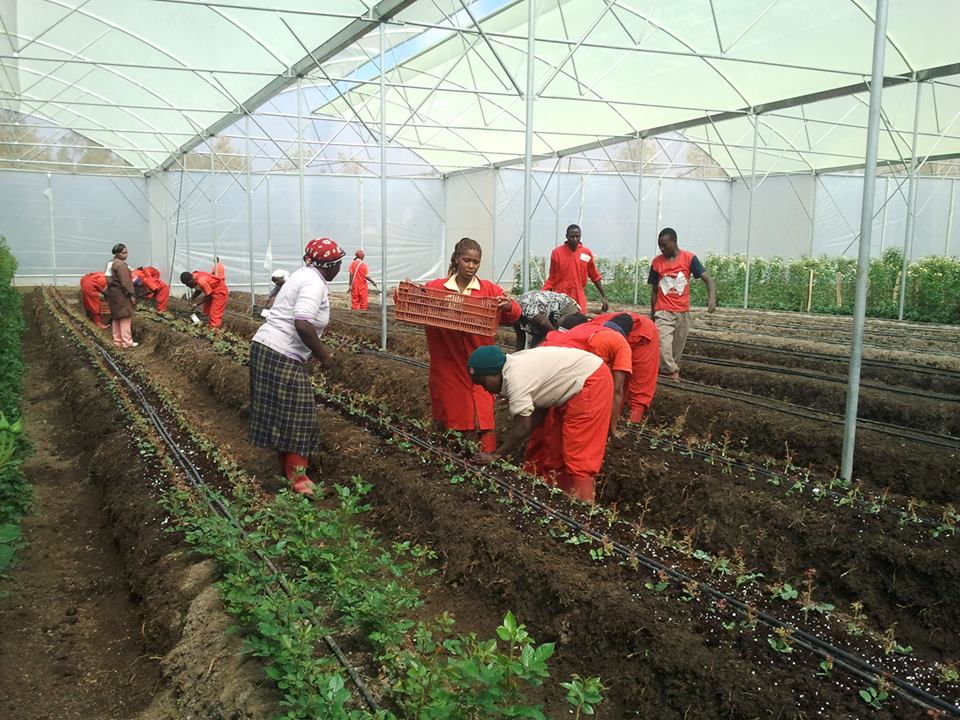Ghana loses about $1.9 billion each year to post-harvest losses. Farmers, who form the backbone of the agricultural sector, employing over 30% of the population and contributing roughly 20% to national GDP, lose up to half their harvests to erratic rainfall, outdated farming methods, and poor storage or market access. At the same time, illegal small-scale mining, known as galamsey, has polluted much of Ghana’s freshwater. Some estimates suggest that about 60% of the country’s rivers and streams are now contaminated, and thousands of hectares of farmland have become unfit for cultivation.
Against this backdrop, Anaporka Adazabra launched Farm.io Limited in 2020 with what she calls “Farms of the Future”: climate-smart greenhouses integrated with precision farming tools, agronomist support, market linkages, and flexible financing.
“Farm.io isn’t just about providing tools; it’s about building a full system that connects farmers from production to market while making them more resilient to climate change,” Adazabra said.
Her work earned her the Bayer Foundation Women Empowerment Award in 2025, drawing international attention to a model that’s quietly changing how Ghana’s smallholder farmers produce and sell food.
Smart greenhouses for year-round production
Farm.io’s modular greenhouses are designed to withstand Ghana’s diverse climate conditions. Built from recycled yet durable materials, she says the structures last over 15 years and protect crops from heat stress, erratic rainfall, and pests.
“In open farming, yields are highly vulnerable to erratic rainfall, pests, and heat stress,” Adazabra explains. “With greenhouses, farmers can grow year-round in controlled environments, optimise water use, reduce pest pressure, and increase productivity up to five times compared to open fields.”
She adds that each unit comes with drip irrigation for efficient water use, ventilation controls for temperature and humidity management, and protective mesh to minimise pest entry. Newer models include digital sensors connected to Farm.io’s USSD platform, allowing farmers to monitor conditions and receive tailored advice.
Recognising that commercial greenhouse systems can be expensive, Farm.io designed modular houses using locally sourced materials. Depending on size, a Farm.io greenhouse starts at around $500 for compact backyard models and scales up to community structures costing a few thousand dollars.
Adazabra says that so far, Farm.io has built and deployed over 200 modular greenhouses across Ghana, from backyard kits for urban growers to larger commercial units for cooperatives. The company has completed more than 100 projects, with most users reporting steady yields throughout the year.
“Instead of harvesting just once or twice a year, farmers can now achieve multiple production cycles and supply vegetables such as tomatoes, peppers, and leafy greens consistently to the market,” she says.
flexible financing models. Adazabra describes a pay-as-you-grow scheme which allows farmers to repay the cost of greenhouses or inputs gradually from harvest proceeds rather than upfront.
“For larger units, we offer lease-to-own models that spread payments across multiple seasons until farmers or cooperatives fully own the infrastructure,” Adazabra explains. “We’re also exploring partnerships with financial institutions and impact investors to unlock low-interest credit and blended finance.”
A digital farm manager in every pocket
Beyond physical infrastructure, Farm.io extends its reach through a digital platform, available as a smartphone app and via USSD for basic phones. According to Adazabra, the platform acts as a farm manager, offering real-time guidance throughout the farming cycle.
“Through the app, or even the USSD version for farmers without smartphones, they can access climate-smart advice, get alerts on irrigation or pest management, track crop growth, and request inputs or services directly from Farm.io,” Adazabra explains. “It also connects them to buyers in advance, reducing postharvest losses.”
For areas with limited connectivity, the USSD service ensures farmers can still request services, check crop schedules, and receive advisory messages without data.
“We built lightweight offline functionality that stores updates and syncs whenever there’s a signal,” she adds. “By combining USSD, SMS alerts, and low-data design, we make sure no farmer is left out, regardless of their device or location.”
To ensure adoption, Farm.io’s field agents provide hands-on demonstrations to train farmers on how to use the tools.
To connect farmers to market, Farm.io operates a dual market strategy, connecting farmers directly with aggregators, retailers, and institutional buyers who commit to purchases in advance, and through its own online shop where farmers can sell directly to consumers. Every harvest goes through standardised sorting, packaging, and quality checks to meet both local and export standards.
Recognition and the journey ahead
Being named a Bayer Foundation Women Empowerment Awardee has been transformative for Farm.io.
“It gave us global exposure and credibility, opening doors to partners, investors, and policymakers who might never have found us otherwise,” Adazabra says, especially useful in a sector investors have previously considered too risky to invest in.
The award also strengthened her platform as a woman entrepreneur in agriculture, connecting her to a network of peers and mentors. Since then, Farm.io has secured new partnerships to expand greenhouse adoption and strengthen farmer financing pipelines.
Operationally, logistics remain the toughest challenge. “Getting inputs, greenhouses, and produce to and from remote farms is complex and costly,” she says. Farm.io is addressing this through better route planning, aggregation hubs, and local partnerships.
Adazabra’s ambitions extend beyond Ghana. Over the next five years, she envisions Farm.io as Africa’s leading platform for climate-smart farming.
“That means scaling our modular greenhouses into every district, so farmers, whether in rural villages or urban backyards, can produce consistently all year round,” she says. “It also means expanding our SuperApp into a one-stop ecosystem for training, financing, inputs, and markets.”
At scale, she believes Farm.io could help millions of farmers feed growing cities and even reach export markets, moving from subsistence to industrial levels of production.
“Our biggest achievement has been proving that smallholder farmers can thrive when technology meets agriculture,” Adazabra says. “We’ve built hundreds of greenhouses, onboarded farmers onto our SuperApp and USSD platforms, and shown that productivity and incomes can rise significantly.”









